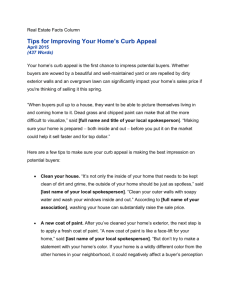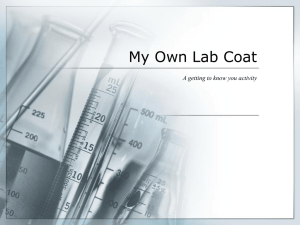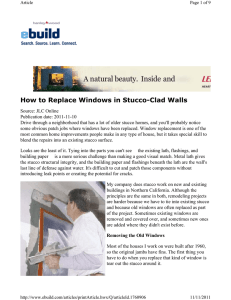Existing system: 2-coat stucco system with a polymer-based system finish... a product similar to a LaHabra Fastwall 100 with an...
advertisement
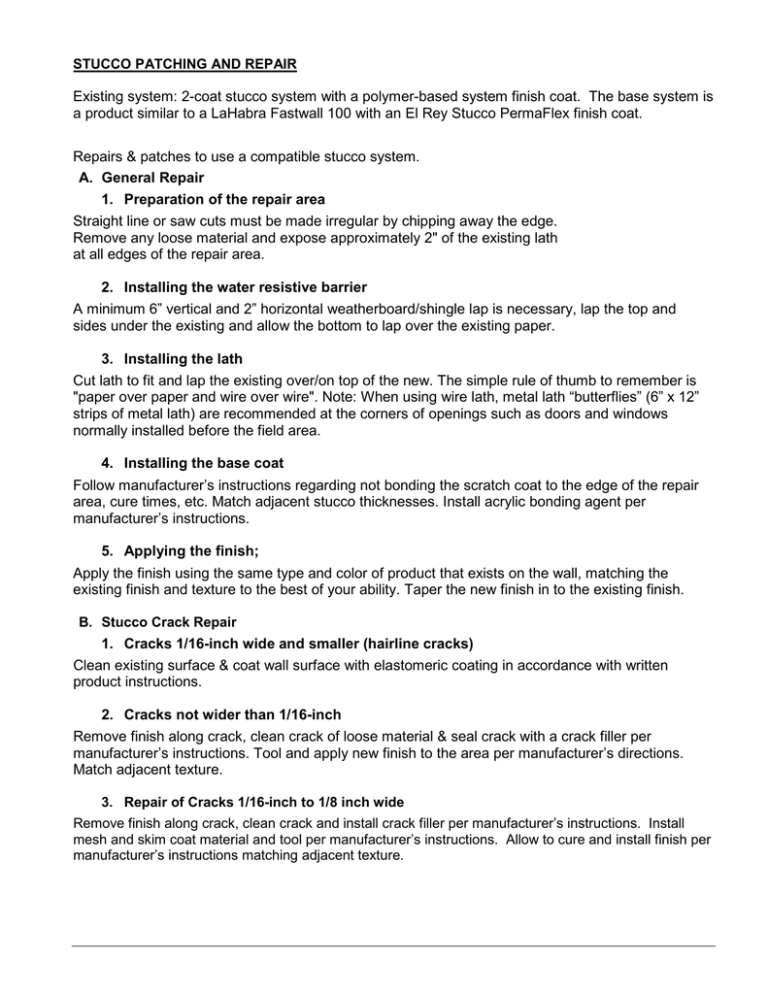
STUCCO PATCHING AND REPAIR Existing system: 2-coat stucco system with a polymer-based system finish coat. The base system is a product similar to a LaHabra Fastwall 100 with an El Rey Stucco PermaFlex finish coat. Repairs & patches to use a compatible stucco system. A. General Repair 1. Preparation of the repair area Straight line or saw cuts must be made irregular by chipping away the edge. Remove any loose material and expose approximately 2" of the existing lath at all edges of the repair area. 2. Installing the water resistive barrier A minimum 6” vertical and 2” horizontal weatherboard/shingle lap is necessary, lap the top and sides under the existing and allow the bottom to lap over the existing paper. 3. Installing the lath Cut lath to fit and lap the existing over/on top of the new. The simple rule of thumb to remember is "paper over paper and wire over wire". Note: When using wire lath, metal lath “butterflies” (6” x 12” strips of metal lath) are recommended at the corners of openings such as doors and windows normally installed before the field area. 4. Installing the base coat Follow manufacturer’s instructions regarding not bonding the scratch coat to the edge of the repair area, cure times, etc. Match adjacent stucco thicknesses. Install acrylic bonding agent per manufacturer’s instructions. 5. Applying the finish; Apply the finish using the same type and color of product that exists on the wall, matching the existing finish and texture to the best of your ability. Taper the new finish in to the existing finish. B. Stucco Crack Repair 1. Cracks 1/16-inch wide and smaller (hairline cracks) Clean existing surface & coat wall surface with elastomeric coating in accordance with written product instructions. 2. Cracks not wider than 1/16-inch Remove finish along crack, clean crack of loose material & seal crack with a crack filler per manufacturer’s instructions. Tool and apply new finish to the area per manufacturer’s directions. Match adjacent texture. 3. Repair of Cracks 1/16-inch to 1/8 inch wide Remove finish along crack, clean crack and install crack filler per manufacturer’s instructions. Install mesh and skim coat material and tool per manufacturer’s instructions. Allow to cure and install finish per manufacturer’s instructions matching adjacent texture. C. Surface Defect Repair 1. Localized finish repair Remove affected finish, Clean exposed brown coat surface to remove all dust, dirt, and other bond-inhibiting materials per manufacturer’s instructions. Install new base and or finish coat per manufacturer’s instructions. Match surrounding stucco texture and color. 2. Replacement of damaged or corroded lath: a. Remove damaged lath minimum 1-inch in all directions beyond area of concern. b. Repair water-resistive barrier system as necessary to correct any damage that is either existing or caused by stucco and lath removal actions. c. Cut replacement lath to provide minimum 1/2-inch overlap on all sides. Wire tie new lath to existing lath at maximum spacing of 8-inches. Provide minimum 4 wire ties for small lath replacements. d. Install stucco base and finish coat per manufacturer’s instructions. 3. Remedial accessory installation a. Remove stucco a sufficient distance from accessory to permit removal of the existing accessory and wire-tie connection of new accessory. b. Cut damaged section of existing accessory and remove from wall. c. Repair water-resistive barrier system if damage is present or occurs as a result of the accessory removal. d. Wire tie new accessory to existing lath at maximum spacing of 8-inches Provide minimum 4 wire ties for small lengths of replacement. e. Align new sections of corner and casing beads carefully to match adjacent accessories. Set both ends of all accessory replacements pieces in wet sealant. f. Install new stucco base coat (s) and cure per manufacturer’s instructions. Install new finish per manufacturer’s instructions. 4. Stucco Delamination from Concrete Substrates a. Define repair area based on sounding and remove stucco to sound substrate. Extend repairs laterally to adjacent well-bonded material. Scarify or chip concrete substrates to provide a surface profile sufficient for bonding of new stucco application. Clean prepared surface to remove all dust, dirt, laitance, oils and other potentially bond inhibiting materials. b. Check ability of surface to receive directly bonded stucco by checking for absorption of water into the concrete. If water does not readily absorb into concrete, provide additional surface preparation or mechanical anchorage for stucco. c. Install stucco in accordance with product instructions. d. Install new finish coat over entire surface to nearest architectural break (joint or corner.) e. EXTERIOR PAINTING PART 1 - GENERAL 1.1 SECTION INCLUDES A. Exterior painting of various unpainted and previously painted concrete, metal and plastic surfaces including pipe, conduit, metal doors, windows, and railings. 1.2 SUBMITTALS A. Product Data: For each type of product. Include preparation requirements and application instructions. B. Samples for Verification: For each type of paint system and each color. 1. Submit Samples on rigid backing, 8 inches square minimum. 2. Step coats on Samples to show each coat required for system. 3. Label each Sample for location and application area. C. Product List: For each product indicated, include the following: 1. Cross-reference to paint system and locations of application areas. 2. Printout of current "MPI Approved Products List" for each product category specified 3. VOC content. 1.3 QUALITY ASSURANCE A. Mockups: Apply mockups of each paint system indicated and each color and finish selected to verify preliminary selections made under Sample submittals. 1. UCCS Project Manager will select one surface to represent surfaces and conditions for application of each paint system specified. 2. Final approval of color selections will be based on mockups. a. If first color selections are not approved, apply additional mockups of additional colors selected by UCCS Project Manager at no added cost to Owner. b. Mockup may remain as part of the work. 1.4 FIELD CONDITIONS A. Apply paints only when temperature of surfaces to be painted and ambient air temperatures are between 50 and 95 deg F (10 and 35 deg C). Do not apply paints in rain, fog, or on wet surfaces. PART 2 - PRODUCTS 2.1 MANUFACTURERS A. Manufacturers: Subject to compliance with requirements, provide products by one of the following : 1. Benjamin Moore & Co. 2. Diamond Vogel Paints. 3. ICI Paints. 4. Kwal Paint. 5. PPG Inc. 6. Sherwin-Williams Company (The). 2.2 PAINT, GENERAL A. MPI Standards: Provide products that comply with MPI standards indicated and that are listed in its "MPI Approved Products List." PART 3 - EXECUTION 3.1 EXAMINATION A. Prior to beginning painting, Applicator shall examine substrates and conditions and certify that surfaces and conditions including moisture content and other conditions affecting performance of the Work are suitable to allowing work to begin. B. Maximum Moisture Content of Substrates: When measured with an electronic moisture meter as follows: 1. Concrete: 12 percent. 2. Gypsum Board: 12 percent. 3. Exterior Gypsum Board Substrates: Verify that finishing compound is sanded smooth. C. Verify suitability of substrates, including surface conditions and compatibility with existing finishes and primers. D. Proceed with coating application only after unsatisfactory conditions have been corrected. 1. Application of coating indicates acceptance of surfaces and conditions. E. Colors: As noted on color schedule . 3.2 PREPARATION A. Comply with manufacturer's written instructions and recommendations in "MPI Manual" applicable to substrates and paint systems indicated. B. Remove hardware, covers, plates, and similar items already in place that are removable and are not to be painted. If removal is impractical or impossible because of size or weight of item, provide surface-applied protection before surface preparation and painting. 1. After completing painting operations, use workers skilled in the trades involved to reinstall items that were removed. Remove surface-applied protection. C. Clean substrates of substances that could impair bond of paints, including dust, dirt, oil, grease, and incompatible paints and encapsulants. 1. Remove incompatible primers and reprime substrate with compatible primers or apply tie coat as required to produce paint systems indicated. D. Steel Substrates: Remove rust, loose mill scale, previously poorly applied paint to smooth surface. Clean using methods recommended in writing by paint manufacturer but not less than the following: 1. SSPC-SP 3, "Power Tool Cleaning." 3.3 APPLICATION A. Apply paints according to manufacturer's written instructions and recommendations in "MPI Manual." 1. Use applicators and techniques suited for paint and substrate indicated. 2. Paint surfaces behind movable items same as similar exposed surfaces. Before final installation, paint surfaces behind permanently fixed items with prime coat only. 3. Paint both sides and edges of exterior doors and entire exposed surface of exterior door frames. 4. Do not paint over labels of independent testing agencies or equipment name, identification, performance rating, or nomenclature plates. 5. Primers specified in painting schedules may be omitted on items that are factory primed or factory finished if acceptable to topcoat manufacturers. B. If undercoats or other conditions show through topcoat, apply additional coats until cured film has a uniform paint finish, color, and appearance. C. Apply paints to produce surface films without cloudiness, spotting, holidays, laps, brush marks, roller tracking, runs, sags, ropiness, or other surface imperfections. Cut in sharp lines and color breaks. D. Painting Fire Suppression, Plumbing, HVAC, Electrical, Communication, and Electronic Safety and Security Work: 1. Paint the following work where exposed to view: a. Equipment, including panelboards and switch gear. b. Uninsulated metal piping. c. Uninsulated plastic piping. d. Pipe hangers and supports. e. Metal conduit. f. Plastic conduit. g. Tanks that do not have factory-applied final finishes. E. Provide 1 gallon each type of paint for each substrate for Owner’s future maintenance. 3.4 CLEANING AND PROTECTION A. At end of each workday, remove rubbish, empty cans, rags, and other discarded materials from Project site. B. After completing paint application, clean spattered surfaces. Remove spattered paints by washing, scraping, or other methods. Do not scratch or damage adjacent finished surfaces. C. Protect work of other trades against damage from paint application. Correct damage to work of other trades by cleaning, repairing, replacing, and refinishing, as approved by UCCS Project Manager, and leave in an undamaged condition. D. At completion of construction activities of other trades, touch up and restore damaged or defaced painted surfaces. 3.5 EXTERIOR PAINTING SCHEDULE A. Concrete Substrates, Non-traffic Surfaces: 1. Latex System: MPI EXT 3.1K a. Prime Coat: Primer, alkali resistant, water based, MPI #3. b. Intermediate Coat: Latex, exterior, matching topcoat. c. Topcoat: Latex, exterior semi-gloss (Gloss Level 5), MPI #11. B. Steel Substrates: 1. Alkyd System: MPI EXT 5.1D a. Prime Coat: Primer, alkyd, anticorrosive for metal, MPI #79. b. Intermediate Coat: Exterior alkyd enamel matching topcoat. c. Topcoat: Alkyd, exterior, semi-gloss (Gloss Level 5), MPI #94. C. Exterior Gypsum Board Substrates: 1. Latex System: a. Prime Coat: Latex, exterior, matching topcoat. b. Intermediate Coat: Latex, exterior, matching topcoat. c. Topcoat: Latex, exterior semi-gloss (Gloss Level 5), MPI #11.
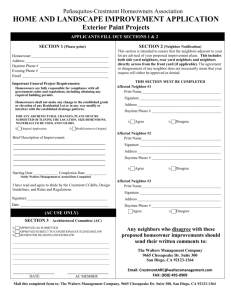

![[Agency] recognizes the hazards of lead](http://s3.studylib.net/store/data/007301017_1-adfa0391c2b089b3fd379ee34c4ce940-300x300.png)


